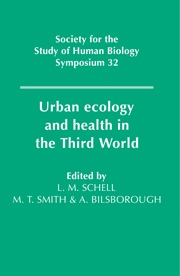Book contents
- Frontmatter
- Contents
- List of contributors
- Acknowledgements
- 1 Human biological approaches to the study of Third World urbanism
- 2 Social and cultural influences in the risk of cardiovascular disease in urban Brazil
- 3 The urban disadvantage in the developing world and the physical and mental growth of children
- 4 Differences in endocrine status associated with urban-rural patterns of growth and maturation in Bundi (Gende-speaking) adolescents of Papua New Guinea
- 5 Nutritionally vulnerable households in the urban slum economy: a case study from Khulna, Bangladesh
- 6 Urban-rural differences in growth and diarrhoeal morbidity of Filipino infants
- 7 Child health and growth in urban South Africa
- 8 From countryside to town in Morocco: ecology, culture and public health
- 9 Urban-rural population research: a town like Alice
- 10 Selection for rural-to-urban migrants in Guatemala
- 11 Health and nutrition in Mixtec Indians: factors influencing the decision to migrate to urban centres
- 12 Urban health and ecology in Bunia, N.E. Zaire, with special reference to the physical development of children
- 13 Food for thought: meeting a basic need for low-income urban residents
- 14 Immunological parameters in northeast Arnhem Land Aborigines: consequences of changing settlement patterns and lifestyles
- 15 Amerindians and the price of modernisation
- 16 Sex ratio determinants in Indian populations: studies at national, state and district levels
- 17 Polarisation and depolarisation in Africa
- 18 Urbanisation in the Third World: health policy implications
- Index
1 - Human biological approaches to the study of Third World urbanism
Published online by Cambridge University Press: 26 December 2009
- Frontmatter
- Contents
- List of contributors
- Acknowledgements
- 1 Human biological approaches to the study of Third World urbanism
- 2 Social and cultural influences in the risk of cardiovascular disease in urban Brazil
- 3 The urban disadvantage in the developing world and the physical and mental growth of children
- 4 Differences in endocrine status associated with urban-rural patterns of growth and maturation in Bundi (Gende-speaking) adolescents of Papua New Guinea
- 5 Nutritionally vulnerable households in the urban slum economy: a case study from Khulna, Bangladesh
- 6 Urban-rural differences in growth and diarrhoeal morbidity of Filipino infants
- 7 Child health and growth in urban South Africa
- 8 From countryside to town in Morocco: ecology, culture and public health
- 9 Urban-rural population research: a town like Alice
- 10 Selection for rural-to-urban migrants in Guatemala
- 11 Health and nutrition in Mixtec Indians: factors influencing the decision to migrate to urban centres
- 12 Urban health and ecology in Bunia, N.E. Zaire, with special reference to the physical development of children
- 13 Food for thought: meeting a basic need for low-income urban residents
- 14 Immunological parameters in northeast Arnhem Land Aborigines: consequences of changing settlement patterns and lifestyles
- 15 Amerindians and the price of modernisation
- 16 Sex ratio determinants in Indian populations: studies at national, state and district levels
- 17 Polarisation and depolarisation in Africa
- 18 Urbanisation in the Third World: health policy implications
- Index
Summary
Of the world's population in 1991 of 5384 million, it is estimated that 43 % live in urban areas (Population Reference Bureau, 1991). Current projections based on data assembled by the United Nations predict that one half of the world's population will be living in urban areas by the year 2005 (United Nations, 1989).
This trend is a continuation of more than several thousand years of urbanisation. However, in the past two centuries the rate of urbanisation has accelerated. Between 1800 and 2000, the world's urban population is expected to have increased 128-fold, yet the world's total population will have increased but 6.4-fold over the same period (Rogers & Williamson, 1982).
Urbanism is unequally distributed among the more and less developed nations. For more than ten years, the urban proportion of the population in developed nations has exceeded 70 % whereas among the less developed nations the percentage of urban residents has remained below 35 % (United Nations, 1989). Although the less developed nations are now less urban, their rate of urban growth is greater (Kurian, 1991). All of the eleven nation-states with the highest annual rates of urban population growth are classed as less developed nations: Sri Lanka, Zaire, Tanzania, Bangladesh, Oman, Yemen (North), Cameroon, Niger, Ivory Coast, Libya and Rwanda (Kurian, 1991). According to United Nations projections (medium variant model; 1989), by the year 2015, fully half of the population in the less developed nations will reside in urban areas, and these nations will have an urban population more than three times that of the more developed nations.
- Type
- Chapter
- Information
- Urban Ecology and Health in the Third World , pp. 1 - 9Publisher: Cambridge University PressPrint publication year: 1993
- 4
- Cited by



